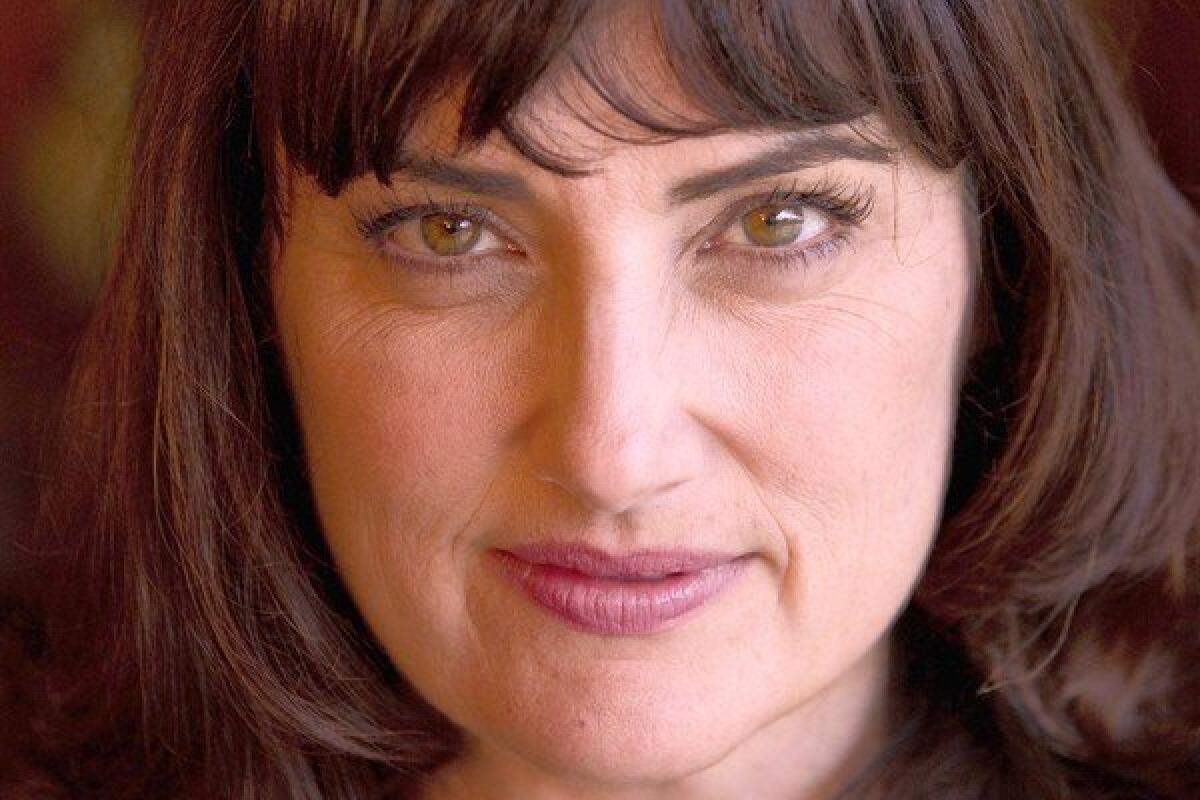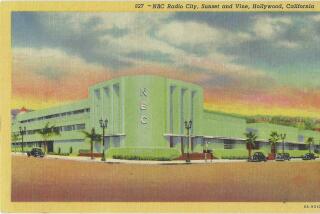Madeleine Brand talks KCET, leaving KPCC and the future

Eight a.m. used to be crunch time for Madeleine Brand. She’d rise at 4:45, arrive each weekday at Pasadena radio station KPCC by 6, and be fully immersed in a frenzy of rewriting and editing during the critical last hour before 9, when “The Madeleine Brand Show” went live.
But on this drizzly Wednesday morning, clad in sweats, a loose wool cardigan, red clogs and not a scrap of makeup, Brand, her hair pinned into a messy bun, relaxes at a local hipster cafe over an 8 a.m. coffee. A dad from her kids’ school stops by to say hello, and she runs into the girlfriend she was out with the night before (they caught the Patti Smith concert).
Until recently, this seemingly nondescript Silver Lake mom reigned over Southern California’s morning public radio airwaves. For August, her show had the highest ratings of any show produced by KPCC-FM (89.3), topping the station’s airing that month of NPR’s “Morning Edition” and “All Things Considered.”
PHOTOS: Celebrites by the Times
But on Sept. 21, a day after her program’s two-year anniversary, Brand, 47, walked away from the show that had been built around her. After 27 years in radio, she’s now a regular contributor on KCET-TV’s “SoCal Connected,” which just last week expanded to a daily format, airing Mondays through Fridays at 7 and 10:30 p.m.
“It was time for me to leave … to have a fresh start,” says Brand in her first extensive interview since she left KPCC. “It’s exciting to know that there’s more than public radio in the world.”
“She’s a great communicator and interviewer … cutting-edge, irreverent, witty, and she’s thoroughly charming on the air,” says KCET chief content officer Bret Marcus, a longtime fan of Brand’s who envisions a “60 Minutes”-style local program with thoughtful, long-form investigative reporting that feeds off the day’s news.
PHOTOS: Hollywood backlot moments
The road to television, however, did not come easily — or, it seems, peacefully. Her departure from radio came after months of tension with her longtime champion, KPCC President Bill Davis, who brought her to the station after she’d made a mark nationally on the NPR show “Day to Day.” The two, who’ve known each other for almost 30 years, Brand says, haven’t spoken since July.
At the heart of the conflict is a $6-million grant (to be spread over three years, in increments of roughly $1.8 million), which the station solicited from the Corporation for Public Broadcasting. The money, which KPCC was awarded last December, was earmarked to develop multicultural programming, diversify newsroom talent and better connect with Southern California’s Latino community. Toward that end, Davis, instead of creating new programming, retooled Brand’s show, expanding it from one to two hours and hiring her a co-host, sports broadcaster and L.A. native A Martinez. The change sparked scores of listener complaints.
“Brand & Martinez,” which premiered Aug. 20, lasted just four weeks.
Martinez is indisputably “easy on the ear,” Brand acknowledges, but she met him only twice before he was brought on. “One little tryout and … a get-to-know-ya coffee,” she says.
Brand had input early in the long process of interviewing potential co-hosts — and was excited about certain candidates, including OC Weekly editor in chief Gustavo Arellano and CNN’s Nick Valencia — but was “surprised” when she found out in an email that the station had hired Martinez, who is known as the voice of ESPN Radio’s “Lakers Line” and “Dodger Talk” on AM 710 but came into the job with little hard-news experience.
“I had no idea what his capabilities were,” she says.
Still, Brand says she wasn’t wedded to being a solo practitioner — she very much enjoyed the co-hosting format when she was on “Day to Day” — and insists she was fully committed to making “Brand & Martinez” work. “You can’t stand in the way of $6 million,” she says. “That’s a lot of money for a public radio station.”
Then, sliding down in her seat and nearly disappearing into the puffy folds of her sweater, she adds: “But it’s all about chemistry. Maybe more in radio than TV because it’s so intimate.”
After Brand left, KPCC’s afternoon anchor on “All Things Considered,” Alex Cohen (one of Brand’s former co-hosts on “Day to Day”), was immediately paired with Martinez on what’s now being called “Take Two.” Brand says she thinks Cohen and Martinez have better on-air chemistry than she and Martinez.
Changing stations
The Brand-KPCC kerfuffle speaks to turbulent shifts in public radio nationwide. Traditionally white and sometimes stodgy, public radio is, by necessity, reinventing itself, aiming both for a younger and more ethnically diverse audience.
Public broadcasting veteran Tom Thomas, co-chief executive of Station Resource Group, a national alliance of public radio stations that includes KPCC and Santa Monica’s KCRW-FM (89.9), calls it a “21st century challenge.”
“Public radio is looking at an America that’s changing — socially, economically, demographically, technologically,” he says. “The question is how to thread the needle of change in a compelling way without walking away from the founding principles of public broadcasting. That’s not an easy thing to do.”
PHOTOS: Celebrites by the Times
“If we’re going to continue to be a viable news operation and grow and add bodies,” says KPCC Vice President of Content Russ Stanton, former editor of The Times, “we have to reach a broader audience.” He’s hired 26 full-time newsroom employees — all relatively young and ethnically diverse — since his arrival in February.
The decision to retool Brand’s show with a Latino host, Stanton says, was made by Davis before he arrived at the station. Stanton completed the search and hired Martinez. “We felt that on air, A’s a really strong broadcasting voice,” Stanton said of Martinez. “He’d shown an ability to tackle tough sports news stories at ESPN. And we’re willing to invest in him.”
Why not simply start a whole new show for Martinez rather than change a show that had already established audience loyalty?
PHOTOS: Hollywood backlot moments
“This was a show that had one of the largest audiences,” Stanton says. “We wanted to go for high impact right out of the gate and not mess around with dabbling off in the corner someplace.”
Pop culture podcaster Luke Burbank, who left as a contributor to KPCC’s morning show after Brand exited — as did sports news comedians the Sklar Brothers, who are making the move with her to KCET — sees absurdity in that decision. “It’d be like CBS deciding they’re not reaching enough young people so they make a ‘Glee’ knockoff and put Dan Rather on as the star,” he says. “Leave the show you have that’s working and create a whole new Latino-themed show that can be awesome on its own.”
“You can’t serve the city of Los Angeles without acknowledging her rich cultural diversity,” wrote one listener on the station’s website after the inaugural “Brand & Martinez” show. “But — and please hear me, KPCC suits — you can’t shortcut your way to Latino membership by using TMBS as a Trojan Horse into that audience.”
Davis chalks up the complaints to audience resistance to change. “The addition of A,” says Davis, who wishes Brand well, “did exactly what we had expected it to do: attract Latino audiences to the program while maintaining the audience that we already had.”
KPCC’s strategy seems to be working. The audience share for the first hour of what’s become “Take Two” went from 2.7 in August to 2.8 in October, compared with 2.5 in October 2011. The Latino percentage of the show’s audience has grown significantly as well — in the 9 to 10 a.m. slot alone, it was 7% in August, 15% in September and 20% in October. Whether the increases are because of audience interest in the presidential race or the station changes won’t be known for several months.
Still, the station as a whole is doing well. In September, KPCC drew an average of 650,000 weekly listeners, according to Arbitron, compared with KCRW’s weekly average that month of 436,800. Where KCRW has the higher national profile — it sponsors concerts around the country and has the power to break new bands — KPCC, through frequent fundraising drives, board members with deep pockets and copious foundation grants, has cash. In 2010, KPCC moved from Pasadena City College to the $24.5-million, 13-studio Mohn Broadcast Center, also in Pasadena.
KCET, Brand’s new public television home, also has big ambitions. After ending its 40-year partnership with PBS in late 2010, the station has struggled with funding. Last year, KCET sold its longtime Hollywood studios to the Church of Scientology and recently merged with satellite network LinkTV. The station is now debt-free, says the station’s executive director of communications, Ariel Carpenter. From its swanky new Burbank offices with a state-of-the-art studio equipped with robotic cameras, the station was able to relaunch “SoCal Connected” as a nightly program partly because of money from the Ahmanson Foundation, which doubled its annual gift to the station in 2012.
Brand envisions incorporating her slick, national sensibility as well as elements from some of her favorite interviewers, including Charlie Rose and CNN’s Christiane Amanpour. “I think I can bring to TV what I brought to my radio show,” she says. “Engaging, intimate, insightful interviews with a dose of humor. I’m gonna see if it’ll work.”
In her first week on air, she interviewed Gov. Jerry Brown about Proposition 30, analyzed election TV ads with Variety political blogger Ted Johnson, and chatted with a financial analyst about the fallout from Hurricane Sandy as well as a panel of experts on climate change related to the storm. It’s a representative mix, she says, of what will likely be five- to eight-minute in-studio interviews.
With just five nightly shows under her belt, Brand acknowledges that being in front of the camera has been a bit nerve-racking. “People are obsessed with women’s hair!” she says. “There’s so much involved in the appearance part of it, and it’s really important to me to keep the journalism part front and center. But it’s super-fun. I think KCET could really take off and be a force in this city.”
A public voice
Brand grew up in the Hollywood Hills and the Bay Area. As an English major at UC Berkeley, she was searching for an extracurricular activity that didn’t involve alcohol and landed at the campus radio station — which Davis ran. When she graduated, Davis hired her as a reporter at Buffalo, N.Y.’s WBFO-FM.
Brand went on to Columbia University’s graduate journalism school and honed her interviewing skills, cycling through public radio newsrooms across the country. She fell in love with long-form, in-depth interviewing at “Morning Edition” in Washington, D.C., while filling in for Bob Edwards as host. But it wasn’t until she landed at NPR’s “Day to Day” in 2003, which she co-hosted at first with Alex Chadwick, that she says she hit her stride.
“There was a freedom to explore my voice,” she says. “And to try something different on the West Coast. They wanted something less formal — and that fit my sensibility.”
The same creative freedom drew Brand to KPCC. “I was handed the keys to the kingdom,” she says. “They said, ‘Do what you do.’” T.M.B.S. was her voice, both literally and artistically — astute cultural and political news reporting to which Brand brought her signature mix of insight, interview polish and accessible, folksy banter. In addition to strong ratings, the show won numerous awards for writing, reporting, features and use of sound, including the 2012 Golden Mike Award.
Letting go of T.M.B.S. and leaving KPCC, she says, was excruciatingly painful. “It was the best job I ever had. It was like creating a baby, gestating that baby, giving birth to that baby, and then someone says, ‘Oh, my God, your baby is so beautiful. I’m gonna take care of it now.’”
On the upside, says Brand, her new work schedule is far more forgiving. “Today I got up at 6:30,” she says almost in disbelief. “Everyone’s telling me I look so rested.” Then, letting a broad smile break loose on her face, she adds: “There’s a lot is going on; I can’t say everything yet, but a lot going on.”
In addition to her KCET role, she’s had talks with the production company SoulPancake about contributing to something on the Oprah Winfrey Network. She’s also been talking with the Disney Junior channel about doing interstitials.
And then there’s the possibility of returning to radio. KCRW General Manager Jennifer Ferro has her eye on Brand.
“When she became available, it was the clear and obvious conversation to have,” Ferro says. “Madeleine’s really talented and definitely belongs on the radio in Los Angeles — we’re gonna try to make that happen.”
PHOTOS, VIDEOS & MORE:
Timeline: Emmy winners through the years
Celebrity meltdowns
VIDEO: Watch the latest fall TV trailers here
More to Read
The complete guide to home viewing
Get Screen Gab for everything about the TV shows and streaming movies everyone’s talking about.
You may occasionally receive promotional content from the Los Angeles Times.







